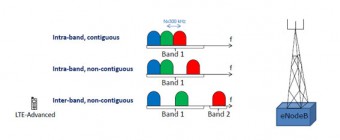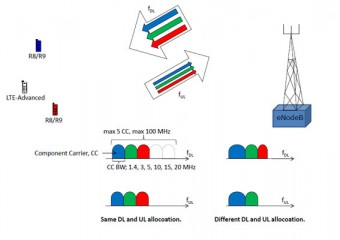| Figure 1. Carrier Aggregation (FDD); The LTE-Advanced UE can be allocated DL and UL resources on the aggregated resource consisting of two or more Component Carriers (CC), the R8/R9 UEs can be allocated resources on any ONE of the CCs. The CCs can be of different bandwidths. |
|---|
Each aggregated carrier is referred to as a component carrier, CC. The component carrier can have a bandwidth of 1.4, 3, 5, 10, 15 or 20 MHz and a maximum of five component carriers can be aggregated, hence the maximum aggregated bandwidth is 100 MHz. In FDD the number of aggregated carriers can be different in DL and UL, see figure 1. However, the number of UL component carriers is always equal to or lower than the number of DL component carriers. The individual component carriers can also be of different bandwidths. For TDD the number of CCs as well as the bandwidths of each CC will normally be the same for DL and UL.
The easiest way to arrange aggregation would be to use contiguous component carriers within the same operating frequency band (as defined for LTE), so called intra-band contiguous. This might not always be possible, due to operator frequency allocation scenarios. For non-contiguous allocation it could either be intra-band, i.e. the component carriers belong to the same operating frequency band, but have a gap, or gaps, in between, or it could be inter-band, in which case the component carriers belong to different operating frequency bands, see figure 2.

| Figure 2. Carrier Aggregation; Intra-band and inter-band aggregation alternatives. The spacing between the centre frequencies of two contiguous CCs is Nx300 kHz, N=integer. For non-contiguous cases the CCs are separated by one, or more, frequency gap(s). |
|---|

